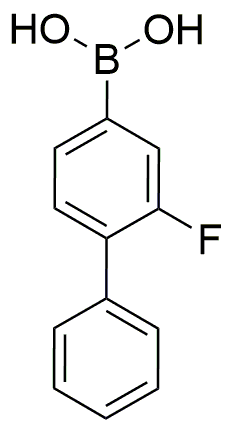2-Fluoro-4-biphenylboronic acid is widely utilized in research focused on:
- Organic Synthesis: This compound serves as a key reagent in Suzuki-Miyaura cross-coupling reactions, allowing chemists to create complex organic molecules efficiently. Its unique structure enhances selectivity and yields in the formation of biaryl compounds.
- Pharmaceutical Development: It plays a crucial role in the development of new pharmaceuticals, particularly in creating compounds that target specific biological pathways. Its ability to form stable complexes with various substrates makes it valuable in drug design.
- Material Science: This chemical is used in the synthesis of advanced materials, including polymers and nanomaterials. Its properties enable the development of materials with enhanced electrical and thermal conductivity, which are essential in electronics.
- Bioconjugation: The compound is utilized in bioconjugation techniques, where it helps attach biomolecules to surfaces or other compounds. This application is vital in creating biosensors and targeted drug delivery systems.
- Research in Catalysis: It is employed in catalytic processes to facilitate various chemical reactions. Its effectiveness in catalysis can lead to more sustainable practices by reducing the need for harsh reaction conditions.
General Information
Properties
Safety and Regulations
Applications
2-Fluoro-4-biphenylboronic acid is widely utilized in research focused on:
- Organic Synthesis: This compound serves as a key reagent in Suzuki-Miyaura cross-coupling reactions, allowing chemists to create complex organic molecules efficiently. Its unique structure enhances selectivity and yields in the formation of biaryl compounds.
- Pharmaceutical Development: It plays a crucial role in the development of new pharmaceuticals, particularly in creating compounds that target specific biological pathways. Its ability to form stable complexes with various substrates makes it valuable in drug design.
- Material Science: This chemical is used in the synthesis of advanced materials, including polymers and nanomaterials. Its properties enable the development of materials with enhanced electrical and thermal conductivity, which are essential in electronics.
- Bioconjugation: The compound is utilized in bioconjugation techniques, where it helps attach biomolecules to surfaces or other compounds. This application is vital in creating biosensors and targeted drug delivery systems.
- Research in Catalysis: It is employed in catalytic processes to facilitate various chemical reactions. Its effectiveness in catalysis can lead to more sustainable practices by reducing the need for harsh reaction conditions.
Documents
Safety Data Sheets (SDS)
The SDS provides comprehensive safety information on handling, storage, and disposal of the product.
Product Specification (PS)
The PS provides a comprehensive breakdown of the product’s properties, including chemical composition, physical state, purity, and storage requirements. It also details acceptable quality ranges and the product's intended applications.
Certificates of Analysis (COA)
Search for Certificates of Analysis (COA) by entering the products Lot Number. Lot and Batch Numbers can be found on a product’s label following the words ‘Lot’ or ‘Batch’.
*Catalog Number
*Lot Number
Certificates Of Origin (COO)
This COO confirms the country where the product was manufactured, and also details the materials and components used in it and whether it is derived from natural, synthetic, or other specific sources. This certificate may be required for customs, trade, and regulatory compliance.
*Catalog Number
*Lot Number
Safety Data Sheets (SDS)
The SDS provides comprehensive safety information on handling, storage, and disposal of the product.
DownloadProduct Specification (PS)
The PS provides a comprehensive breakdown of the product’s properties, including chemical composition, physical state, purity, and storage requirements. It also details acceptable quality ranges and the product's intended applications.
DownloadCertificates of Analysis (COA)
Search for Certificates of Analysis (COA) by entering the products Lot Number. Lot and Batch Numbers can be found on a product’s label following the words ‘Lot’ or ‘Batch’.
*Catalog Number
*Lot Number
Certificates Of Origin (COO)
This COO confirms the country where the product was manufactured, and also details the materials and components used in it and whether it is derived from natural, synthetic, or other specific sources. This certificate may be required for customs, trade, and regulatory compliance.


